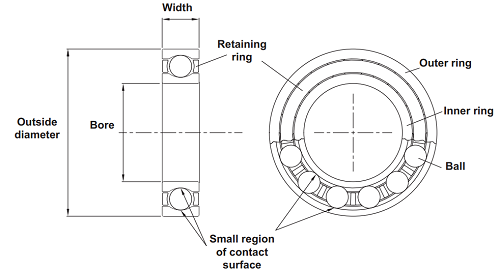Related Resources: calculators
Bearing Design for Life and Selection Formulae and Calculator
Bearing Application, Specifications and Engineering
Bearing Design for Life and Selection Calculator
The load on a rolling contact bearing is exerted on a very small area as illustrated in Figure 1. Should the resulting contact stresses are very high and of the order of 2000 MPa. Despite very strong steels (e.g. BS 970 534 A99, AISI 52100) all bearings have a finite life and will eventually fail due to fatigue. For two groups of apparently identical bearings tested under loads P1 and P2, the respective lives L1 and L2 are related by the life equation given in Eq. 1
Preview Bearing Design for Life and Selection Calculator

Contact area for a ball bearing.
Eq. 1
where
L1 = life at load
P1 (number of revolutions),
L2 = life at load
P2 (number of revolutions),
P1 = load (N),
P2 = load (N),
k ≈ 3 for ball bearings,
k ≈ 3.33 for cylindrical roller bearings.
The dimensions for rolling element bearings have been standardized and can be purchased as stock items from specialist manufacturers and suppliers. The selection of a bearing from a manufacturer's catalog involves consideration of the bearing load carrying capacity and the bearing geometry. For a given bearing, the load carrying capacity is given in terms of the basic dynamic load rating and the basic static load rating.
The basic dynamic load rating, C, is the constant radial load which a bearing can endure for 1 x 106 revolutions without evidence of the development of fatigue in any of the bearing components.
The life of a ball bearing, L, is the number of revolutions (or hours at some constant speed), which the bearing runs before the development of fatigue in any of the bearing components.
Fatigue occurs over a large number of cycles of loading. For a bearing, this would mean a large number of revolutions. Fatigue is a statistical phenomenon with considerable spread of the actual life of a group of bearings of a given design. The rated life is the standard means of reporting the results of many tests of bearings. It represents the life that 90% of the bearings would achieve successfully at a rated load. The rated life is referred to as the L10 life at the rated load. The rated life, L10, of a group of apparently identical bearings is defined as the number of revolutions (or hours at some constant speed) that 90% of the group of bearings will complete before the first evidence of fatigue develops.
If in Eq. 1, P2 = C and the corresponding life L2 = 1 x 106 , then the life of a bearing L, with basic dynamic load rating C with a load P, is given by
Eq. 2
where
L = life (millions of revolutions),
C = basic dynamic load rating (N),
P = load (N)
When selecting a particular bearing from a manufacturer's catalog, it is useful to know the required basic dynamic load rating C for a given load P and life L, which is given by
Eq. 3
Source
Mechanical Design Engineering Handbook
Peter R. N. Childs
2014
Related:
- Bearing Life Formula Based on Speed, Load and Hardness, Ball Bearings, Radial Bearings, Thrust Bearings Ball Bearings life is related to load and speed of rotation, and this relationship must be considered when selecting bearings for various speed and life requirements.
- Bearing Load Calculator Excel Spreadsheet Design engineering spreadsheet calculates the loads on linear motion bearings. *Premium Membership Required*
- Bearing Types and Application Design, Ball Bearings, Roller Bearings, Thrust Bearing Type Description Friction Stiffness † Speed Life Notes Plain bearing Rolling element bearing Jewel bearing Fluid bearing Magnetic bearings Flexure bearing
- Journal Bearing Lubrication Analysis Formulas and Calculator The primary advantage of a fluid film bearing is often thought of as the lack of contact between rotating parts and thus, infinite life.
- Thrust Ball Bearings Magnitude of Life Ratings Use the following equation to calculate the magnitude of life rating .
- Typical Bearing Life in hours for Various Design Applications
- Bearing Shaft and Housing Installation Tolerances Size and fit tolerances for bearing mating shafts and housing are provided within the tables below are defined by ISO tolerances for shafts and housings (ISO 286) in conjunction with the tolerances
Δ dmp for the bore andΔ Dmp for the outside diameter of the bearings per. (DIN 620). - Bushing and Plain Bearings Press or Shrink Fit Design and Application Press fit or shrink fit bushing design and installation is a common method of retaining bearings by use of interference between the bushing and the bushing hole.
- Critical Speeds of Rotating Shafts with Single Loads When calculating critical speeds, the weight or mass of the rotating cylinder or shaft is assumed to be zero or add 1/2 to 2/3 of the rotating shaft to the load mass.